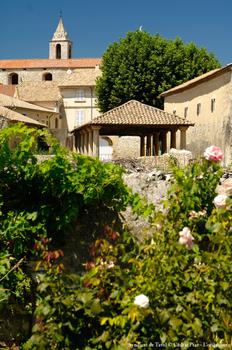Tavel and its surrounding region
Village of the 1st Rosé of France, ideally situated between the City of Avignon and the widely known Pont du Gard, Tavel derives its wealth and fame from its famous rosé wine, but also from its soil and sub-soils : its terroir and its Tavel stone.
 Tavel is an ideal base for visitors who wish to explore the numerous possibilités of local interest. They can bask in the peace and quiet of a wine-making village and discover the local history by following the various tourist routes available :
Tavel is an ideal base for visitors who wish to explore the numerous possibilités of local interest. They can bask in the peace and quiet of a wine-making village and discover the local history by following the various tourist routes available :
- Discovery of the ancient village centre: church, fountain, rue du Tomple, the old wash-house, the allotments and the chemin de la Condamine, the 10th century chapel of Saint-Ferréol…
- The Vineyard route, recently developed by the Tavel AOC Syndicate
-
The country lane leading to the sun dial (the biggest sun dial in Europe) and botanical trail.
Visitors can become acquainted with local culture by visiting the numerous wine cellars and local stone works.
Or visitors can relax in the open air in the squares and gardens that full of flowers and shady trees, or on the hillsides covered with garrigue (mediterranean shrubland) that surround our village.
In addition, the restaurants, chambres d’hôtes, hotels and shops are all there to welcome visitors and do their utmost to make sure that their stay in the village of the king of rosé wines will be unforgettable.
Near the village of Tavel
Pont du Gard et Uzège
The Pont du Gard, an absolute must for visitors
The acqueduct of Nimes, built around 50 AD during the empires of Claudius and Nero, to carry water over 50 kilometres from the source of the river Eure to the storage reservoir (Castellum) in Nîmes.
Uzès
Another visitors’ must : the city of Uzès, originally called Uzetia. It became an episcopal city and a consulate. The Duchy was created in 1572 under the reign of Charles IX and its particularity is that it still belongs to the same family : the Crussol d’Uzès.
Discover the Camargue
Landscapes of Camargue
The first thing that is noticed in Camargue is, of course, the subtle combination of fresh water and salt water and the unforgettable and particularly striking pure lines of the landscape which melt into a shimmering blue haze.
Spend peaceful and enjoyable days in the Camargue
The Canal flows smoothly through the gardois Camargue for about 30 kilometres, linking the Rhône to the Mediterranean sea at Grau du Roi. A natural Waterway to be used without moderation...
Nîmes and its surrounding region
The colour of stone is dominant in Nîmes.
If the Arena in Nîmes still rings with the clamour of the roman jubilation, the contemporary creations by well-known architects are in complete harmony with the very heart of the city.
www.ot-nimes.fr
Nîmes , melting-pot of culture and history
Forged over more than four millenia, the spirit of Nîmes has always sought to share knowledge, from the menhir of Courbessac to the paintings by Claude Viallat. A handful of Gauls who settled around a source and associated their settlement with the god of water, Nemausus.
Secrets of the garrigue
The shrubland called « garrigue » is shared by two elements : olive trees and dry stone. This is the way that man has been able to tame this apparently hostile vegetation. The olive tree, symbol of the Mediterranean, has been growing in and around Nîmes for millions of years.
Avignon
You will be impressed by the beauty of Avignon and the diversity of its heritage, with its legendary bridge and the famous Palace of the Popes, the ramparts, the 17th and 18th century mansions in the old part of the city , the gardens, churches and museums with their unbelievable treasures
Orange
Situated in the middle of the rhône valley, Orange benfits for a perfect sitting to experience Provence.
Orange has two important landmarks from the roman period: the triomphal arche and the antique theatre, monuments ranks as Unesco wrld heritage site.

